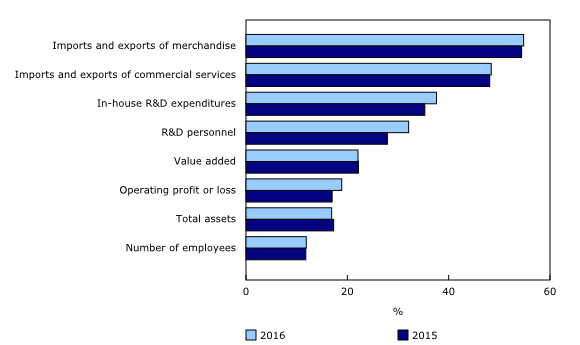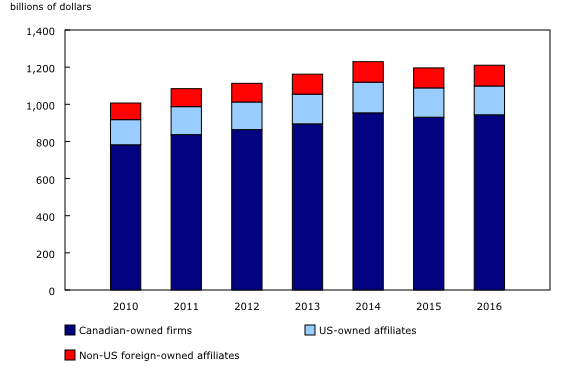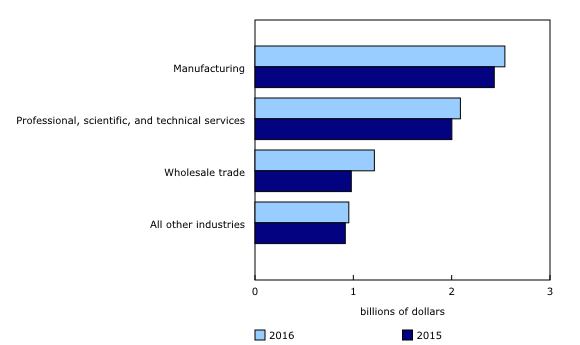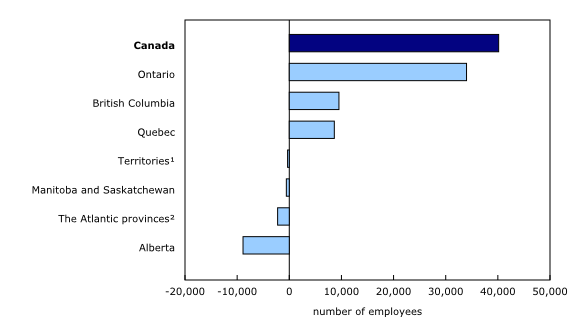Activities of foreign majority-owned affiliates in Canada, 2016
Archived Content
Information identified as archived is provided for reference, research or recordkeeping purposes. It is not subject to the Government of Canada Web Standards and has not been altered or updated since it was archived. Please "contact us" to request a format other than those available.
Released: 2018-11-14
$267.1 billion
2016
Foreign majority-owned affiliates operating in Canada generated over one-fifth of the value added in the corporate sector in 2016 and employed about one in eight Canadian workers. These companies were responsible for 54.1% of Canada's total merchandise and commercial services trade, up 0.3% from 2015.
As well, foreign-owned affiliates reported profit growth that outstripped their Canadian-owned counterparts. Foreign-owned firm profits rose 16.2% to $81.8 billion in 2016, compared with 2.5% growth for Canadian-owned firms, with profit growth widespread across most industries.
Overall, the activities of foreign-owned firms increased on a broad base of indicators, including operating revenues, operating profits, value added, research and development (R&D) expenditures, and number of employees.
Many of the gains in 2016 were related to mergers and acquisitions in the wholesale, retail, and information and cultural industries, which resulted in increased foreign ownership. These gains were moderated by a second annual decline of activities in mining, quarrying, and oil and gas extraction, which were dampened by continued low energy prices.
Foreign-owned firms generate over one-fifth of the value added in the corporate sector
One of the key indicators measuring the importance of foreign-owned firms in the Canadian economy is their contribution to the country's gross domestic product (GDP), also referred to as value added. In 2016, they were responsible for 22.1% of Canada's corporate sector value added, and 14.2% of Canada's total GDP.
By comparison, foreign-owned firms in Germany also accounted for around one-fifth of its value added in 2015, while the shares in France and Italy were less, at about 15% each. In the United States, this proportion was much lower at 6.4% in 2016, reflecting the greater relative importance of foreign-owned firms in Canada.
In 2016, foreign-owned firms generated $267.1 billion of value added in Canada, led by those operating in manufacturing and, to a lesser extent, wholesale trade.
Value added by foreign-owned affiliates rose 0.6% from 2015 to 2016. Gains in wholesale trade and in information and cultural industries were partially offset by declines in the construction and the finance and insurance sectors.
On a country basis, affiliates ultimately owned by US firms were responsible for $155.2 billion value added in 2016, or 12.8% of the Canadian corporate sector total. Along with the United States, affiliates from the United Kingdom, Japan, Germany, and France combined contributed 17.4% of Canada's corporate sector value added. The Asia and Oceania region, led by Japan, accounted for 2.6%, a share that has been trending upwards since 2010.
Asian and Oceanian firms report highest research and development growth rate
Foreign affiliates accounted for nearly two-fifths of in-house R&D expenditures, and one-third of R&D personnel in Canada in 2016. While the total number of R&D personnel in Canada decreased by 13.0% to 141,300 workers from 2015 to 2016, R&D personnel at foreign-owned firms were relatively stable at 45,300. The value of in-house R&D expenditure by foreign-owned affiliates rose 7.4% to $6.8 billion in 2016.
At an industry level, in-house R&D expenditures by foreign-owned firms were concentrated in the manufacturing sector, the professional, scientific, and technical services sector, and the wholesale trade sector. These all grew in 2016. In contrast, foreign firms involved in mining, quarrying, and oil and gas extraction saw a significant decline in R&D expenditures.
Asia and Oceania saw the largest growth in R&D among the regions, with their affiliates expanding in-house R&D expenditures by 28.3% and personnel by 22.6% in 2016. Japan was a large contributor to this growth.
Employment growth highest at foreign-owned firms located in Ontario
Employment at foreign-owned affiliates rose by 2.2% to 1.90 million in 2016, mostly in Ontario. Employment was also up in British Columbia and Quebec, but the growth was moderated by lower employment levels in Alberta and the Atlantic provinces.
Employment growth in Ontario was widespread across all industries, with the largest increases in information and cultural industries, retail trade, transportation equipment manufacturing, and wholesale trade.
Note to readers
Foreign majority-owned Canadian affiliates are identified using data on foreign direct investment in Canada and are defined as Canadian entities where a foreign direct investor owns more than 50% of the voting shares. Users should note that these entities include firms that are also engaged in Canadian direct investment abroad.
The terms foreign-owned affiliates or foreign-owned firms refer interchangeably to foreign majority-owned Canadian affiliates in this release.
For the geographical dimension, two bases are used to present the ownership of foreign majority-owned firms: the country of the immediate investor, and the country of the ultimate investor. The immediate investing country shows the first foreign country of inter-company claims. The ultimate investing country indicates the economy from which the investment ultimately originates and where the control resides through layers of inter-corporate ownerships.
Round tripping refers to an investment structure where funds from an enterprise in one economy are invested in an enterprise resident in a second economy and are then invested in another enterprise in the first economy. In this release, data allocated to Canada on an ultimate basis illustrate the characteristics of enterprises whose ownership starts in Canada, is then routed through one or more foreign countries, and then ends up back in Canada.
Analysis is done for the ultimate investing country basis of ownership unless otherwise noted in the text.
Data on intramural (in-house) research and development (R&D) expenditures and R&D personnel are now available from 2010 to 2016. The Research and Development in Canadian Industry (RDCI) survey was redesigned for reference year 2014. As a result, comparisons between 2014 and prior years for intramural (in-house) R&D expenditures and R&D personnel should be done with caution.
International technological services (payments and receipts) concern foreign transactions made by enterprises for patents (sale or licensing) and unpatented inventions, know-how, trademarks, designs and patterns, technical services, industrial R&D carried out abroad, and foreign sources of funds for intramural R&D projects.
The primary statistical unit used in this analysis is the enterprise, except for provincial employment data which are compiled at the establishment level.
In this release, data on the value added of foreign-owned firms in Germany, France and Italy were taken from Eurostat. Similar data for the United States were taken from the Bureau of Economic Analysis.
Canada's total gross domestic product (GDP), also known as "value added," at basic prices was derived from table 36-10-0221-01.
Products
The updated Canada and the World Statistics Hub (13-609-X) is available online. This product illustrates the nature and extent of Canada's economic and financial relationship with the world using interactive graphs and tables. This product provides easy access to information on trade, investment, employment, and travel between Canada and a number of countries, including the United States, the United Kingdom, Mexico, China, and Japan.
The Methodological Guide: Canadian System of Macroeconomic Accounts (13-607-X) is available.
The User Guide: Canadian System of Macroeconomic Accounts (13-606-G) is also available. This publication will be updated to maintain its relevance.
Contact information
For more information, contact us (toll-free 1-800-263-1136; 514-283-8300; STATCAN.infostats-infostats.STATCAN@canada.ca).
To enquire about the concepts, methods, and data quality of this release, contact Andreas Loken (613-402-2436; andreas.loken2@canada.ca), International Accounts and Trade Division.
- Date modified:





